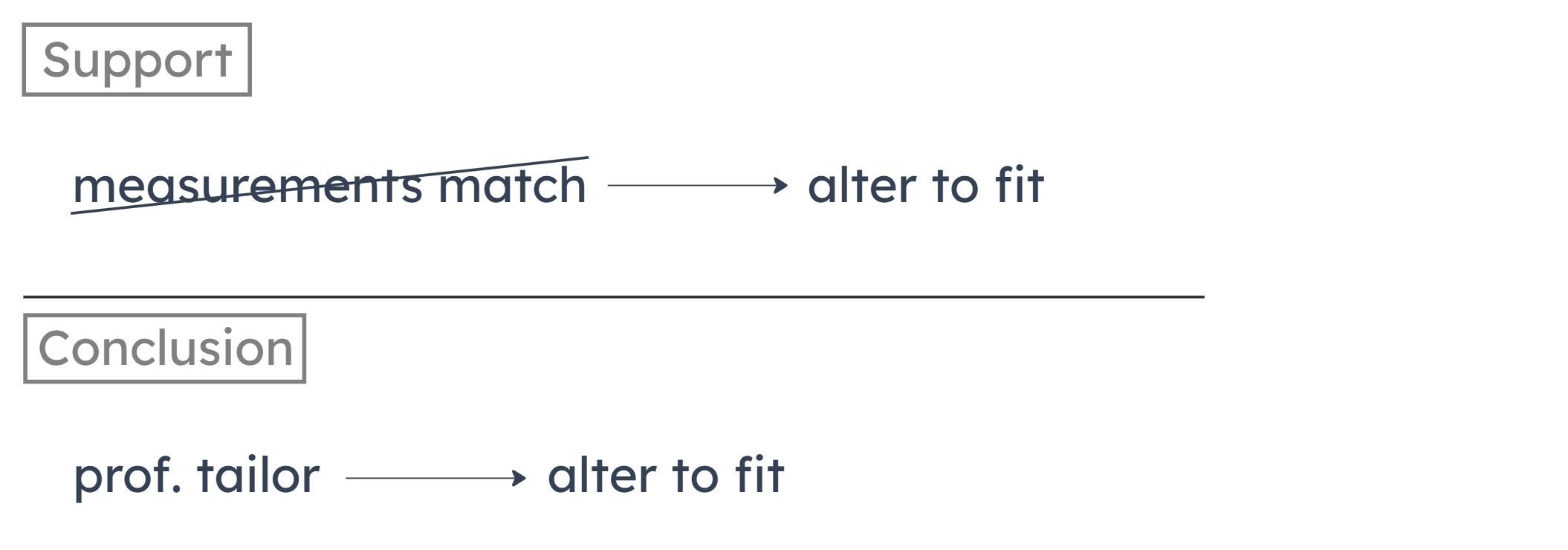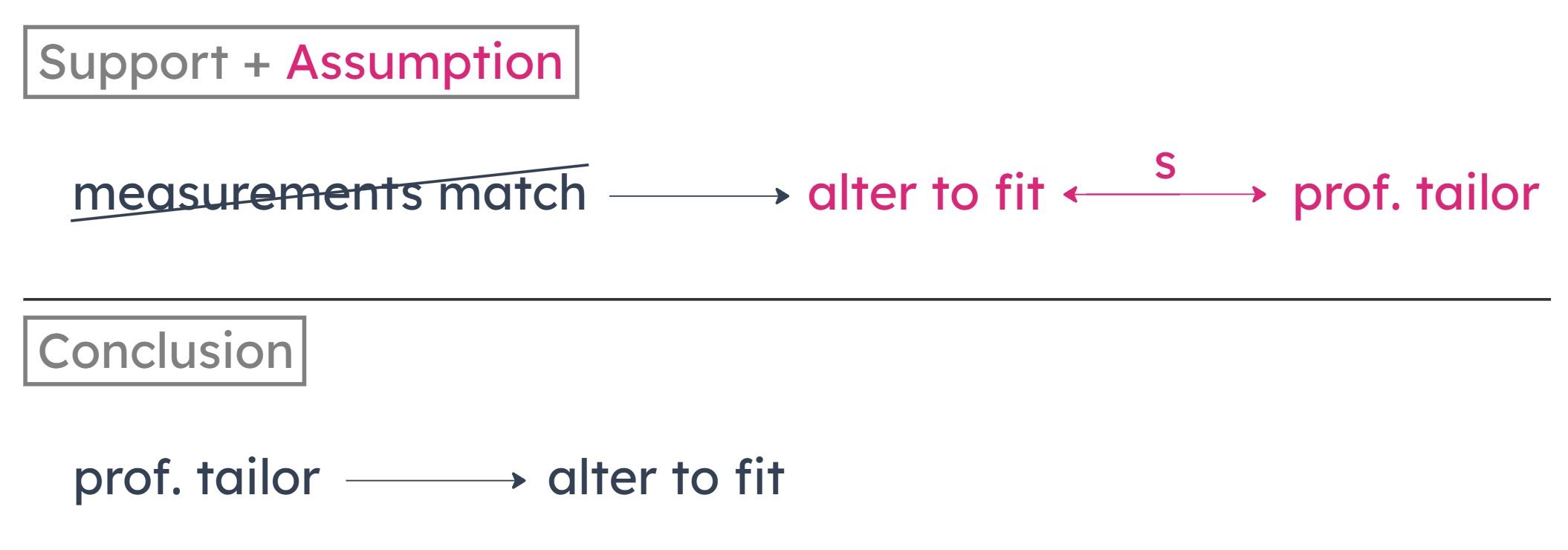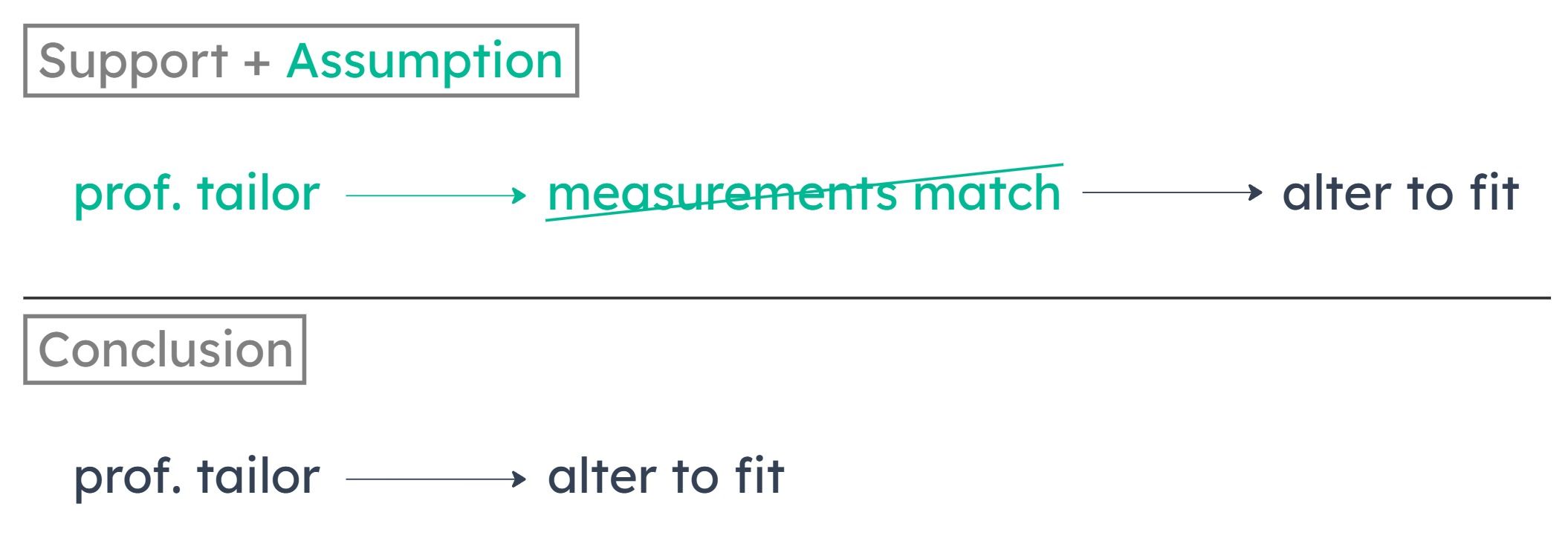Note that the first sentence provides no support for the conclusion.

Also, the conclusion is that professional tailors always alter the pattern, no exceptions. But the premise allows for an exception: tailors in general alter the pattern unless the wearer’s measurements already match the pattern.
The premise would lead to the conclusion if we knew that for professional tailors specifically, the exception never applies. That is, for a professional tailor, the wearer’s measurements never match the pattern.
A
Most manufactured patterns do not already accommodate the future distortion of fabrics that shrink or stretch.
B
At least some tailors who adjust patterns to the wearer and to the fabrics used are professional tailors.

C
The best tailors are those most able to alter patterns to fit the wearer exactly.
D
All professional tailors sew only for people whose measurements do not exactly match their chosen patterns.

E
A professional tailor can always estimate exactly how much a fabric will shrink or stretch.
A
The designs that turn out best go through the most drafts.
B
Many good designs have emerged from design ideas that were flawed.
C
Designs that do not turn out well have not gone through many drafts.
D
Designs whose initial conceptualization was inadequate rarely turn out well.
E
A designer will never see advantages and flaws in a design idea without the aid of a sketch.
A
Sticklebacks with armor are unable to swim as fast, making them most vulnerable to fast-moving predators.
B
Having a larger size is an important factor in whether lake stickleback, but not ocean stickleback, survive cold winters.
C
Unlike ocean stickleback, the lake stickleback are more often preyed upon by predatory insects than by larger fish.
D
Both ocean stickleback and lake stickleback feed primarily on the same types of foods.
E
Sticklebacks originated in the ocean but began populating freshwater lakes and streams following the last ice age.
A
The company surveyed potential customers and discovered that most of them were more concerned about cost than about safety.
B
The company could significantly increase the car’s safety without dramatically increasing its production cost.
C
Most people who bought the new car were probably unaware that it is much less safe than other cars.
D
Many households that previously could afford only one car can now afford two.
E
Most people who bought the new car previously travelled by bicycle or motorcycle, which are less safe than the new car.
A
treats a statement as established fact merely because a self-appointed expert has asserted it
B
draws a conclusion that merely restates a premise offered in support of it
C
treats a condition that must occur in order for an effect to occur as a condition that would ensure that the effect occurs
D
concludes that one part of a change was responsible for an effect without ruling out the possibility that other parts of that change were responsible
E
concludes that making a dietary change improved the health of a particular person simply because that change results in improved health for most people
Researcher: Newly formed neurons can help to heal an injured brain but only if they develop into the type of neurons that are most common in the injured area. Studies have shown that when a part of the brain called the striatum is injured, newly formed neurons in the striatum never become midsized spiny neurons, the type most common in the striatum.
Summary
The stimulus can be diagrammed as follows:

Notable Valid Inferences
If the striatum is injured, then newly formed neurons will not help heal the injury.
A
Newly formed neurons sometimes develop into midsized spiny neurons in areas of the brain other than the striatum.
Could be false. We don’t have any information about neuron development into midsized spiny neurons outside of the striatum.
B
Newly formed neurons are commonly found in injured areas of the brain shortly after the injury occurs.
Could be false. We don’t know anything about the amount of time between injury and appearance of newly formed neurons.
C
Midsized spiny neurons are not the most common type of neuron in any part of the brain other than the striatum.
Could be false. We don’t know anything about what kinds of neurons are most common in areas of the brain other than the striatum.
D
In cases of injury to the striatum, newly formed neurons will not help to heal the injury.
Must be true. As shown below, by chaining the conditional relationships, we know that if the striatum is injured, then the newly formed neuron will not help heal the injury.

E
In most cases of brain injury, newly formed neurons do not help to heal the injury.
Could be false. We don’t have any information about the quantity of brain injuries that are or aren’t healed with the assistance of newly formed neurons.
A
some of Thompson’s reasoning is circular
B
Thompson provides no definition of the concept of a “self-identified agent”
C
the analysis of character offered by Thompson is insufficiently supported by the textual evidence
D
it is unlikely that any character could qualify as a “self-identified agent”
E
some of Thompson’s claims contradict each other
A
Most people are skeptical of the descriptions that accompany items when they are put up for auction online.
B
People are likely to assume that a car with no reported defects has been maintained more attentively and is therefore in better overall condition.
C
Prospective buyers are likely to overlook mention of defects buried in a detailed description of the condition of an object they are considering purchasing.
D
Listing defects in a description of an item tends to lead people to assume that no major defect has gone unmentioned.
E
With thousands of cars for sale, prospective buyers are unlikely to read detailed descriptions of more than a small fraction of them.